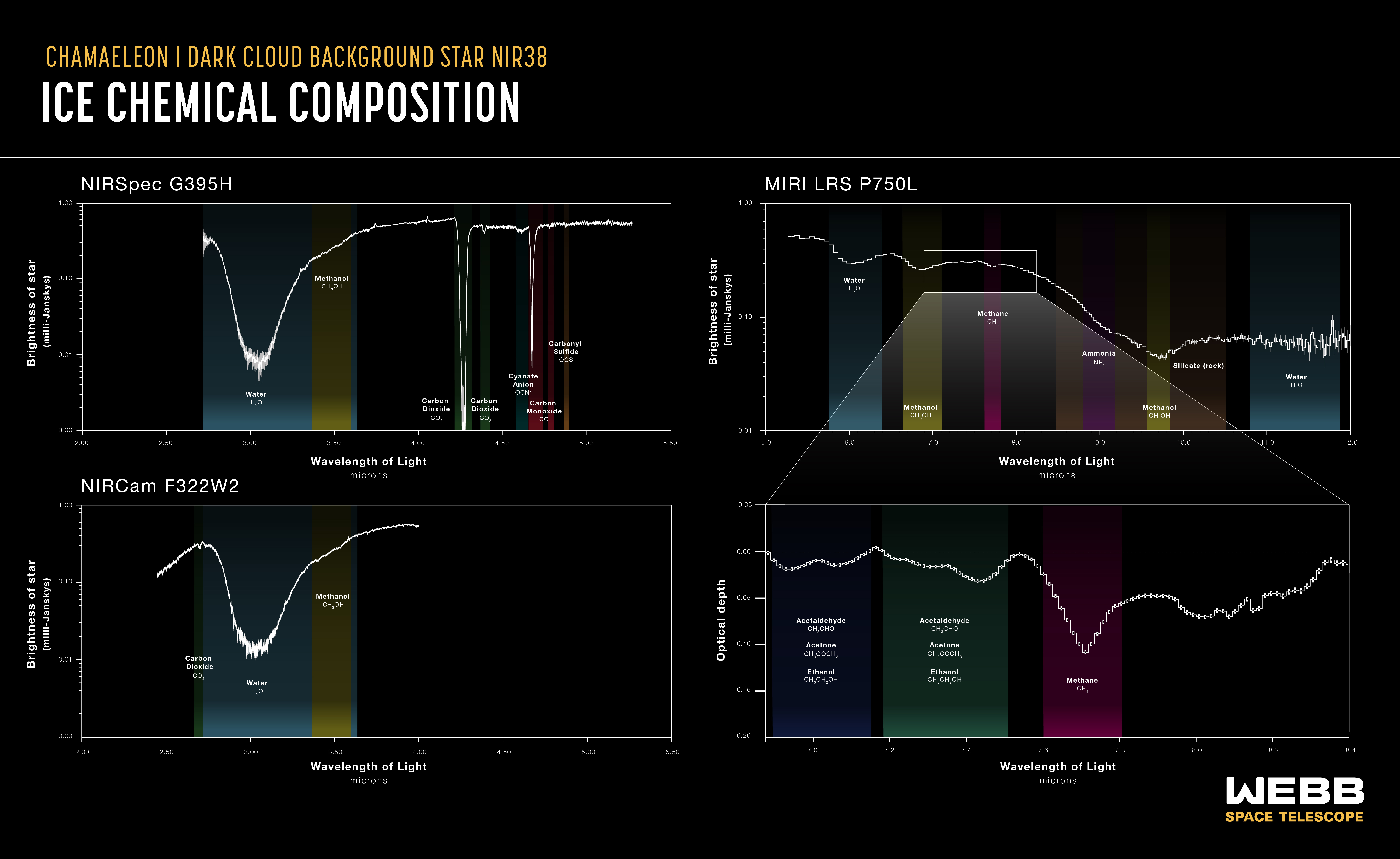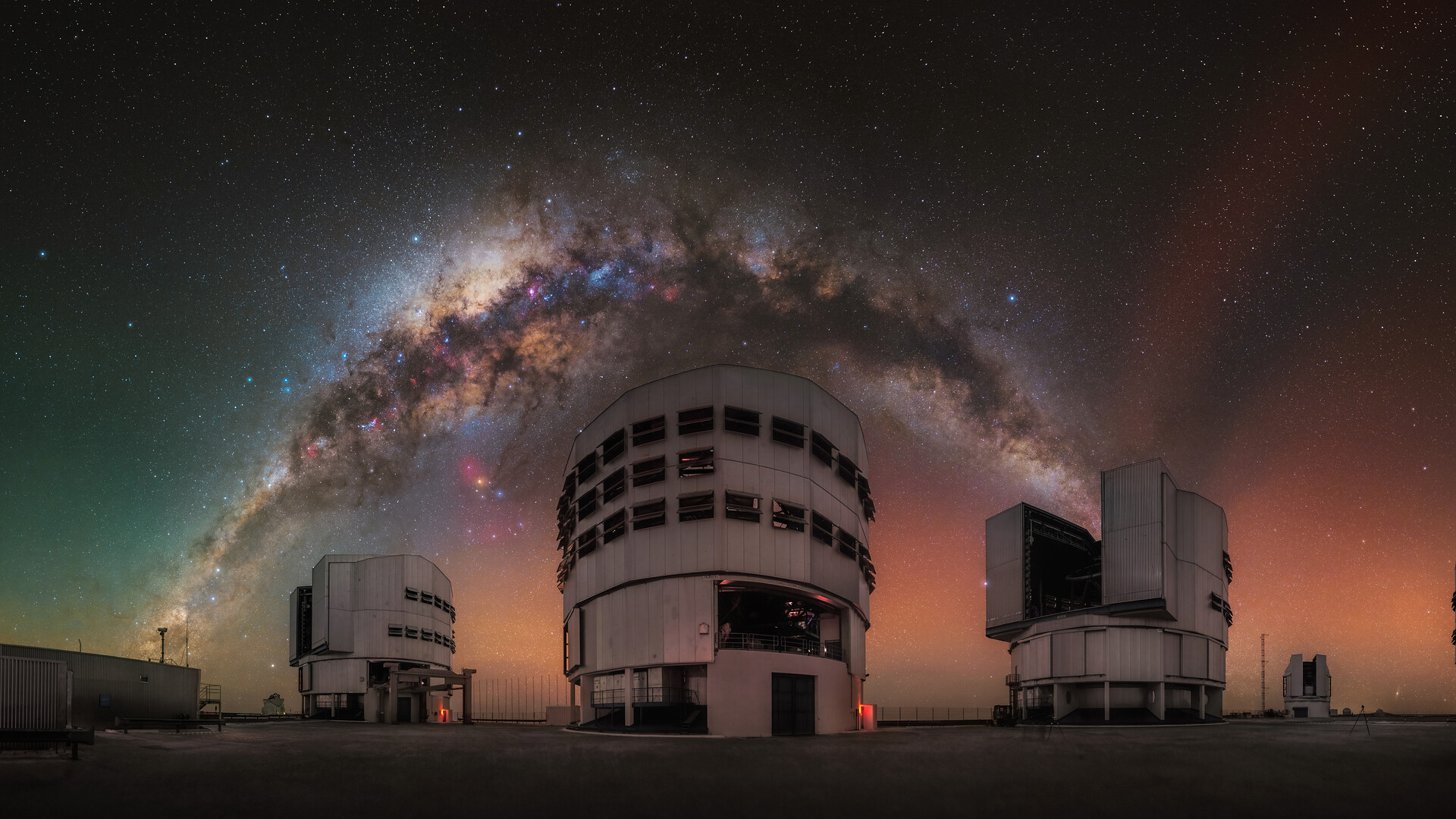James Webb Space Telescope discovers coldest interstellar ice ever seen
NASA's newest space telescope isn't just stretching astronomers' view deeper into the universe, it's also reaching colder temperatures than scientists have before.
The James Webb Space Telescope (JWST or Webb), the most powerful space observatory yet, has peered deep into a dense molecular cloud and found a rich variety of pristine interstellar ice — including a range of molecules crucial for life. Spotted at frigid temperatures of minus 440 degrees Fahrenheit (minus 263 degrees Celsius), these finds are the coldest ices ever measured.
"We simply couldn't have observed these ices without Webb," Klaus Pontoppidan, an astronomer at the Space Telescope Science Institute and an author of a new study describing the work, said in a statement.
Related: James Webb Space Telescope's best images of all time (gallery)
Webb studied a neighborhood that scientists call Chameleon I. Located in the southern constellation of Chameleon, about 500 light-years away from Earth, it's one of the closest star-forming regions, with dozens of pockets alive with young stars. The region belongs to a family of what astronomers long thought to be holes in the sky: dark molecular clouds so dense with gas and dust that visible light from background stars fails to penetrate them.
Clouds like Chameleon I are stellar nurseries; their collapse over time forms stars and potentially rocky planetary systems. The chemical composition of these systems and any building blocks of life they may contain, however, is determined by the ices embedded deep inside the molecular cloud.
Now, thanks to Webb's powerful instruments, including its deep-penetrating near-infrared camera (NIRCam), astronomers have probed into Chameleon I's dusty heart and discovered ices at their early stages of evolution — just before the cloud's core collapses to form protostars.
Breaking space news, the latest updates on rocket launches, skywatching events and more!
The team used light from two background stars, NIR38 and J110621, to light up Chameleon I in infrared wavelengths. The cloud's different molecules that are locked in ices absorb starlight in different infrared wavelengths. Astronomers then studied the chemical fingerprints that showed up as dips in the resulting spectral data. This data helped the team identify how much of which molecules are present in Chameleon I.
"Pristine cloud ices"
The team spotted an expected assortment of major life-supporting compounds: water, carbon dioxide, carbon monoxide, methane and ammonia. The observations also revealed signs of carbonyl sulfide ice, which allowed the first measurements of how much sulfur — yet another element required by Earth's life, at least — is present in the molecular clouds. The researchers also detected the simplest complex organic molecule, methanol, which is thought to be an unambiguous indicator of complex, early chemical processes that happen in the early stages of star and planet formation.
"This is the first time researchers have been able to study the composition of so-called pre-stellar ices near the center of a molecular cloud," Melissa McClure, an astronomer at Leiden Observatory in the Netherlands and the lead author of the study, said in a second statement.

The fact that the team detected methanol suggests that the stars and planets that would eventually form in this cloud "will inherit molecules in a fairly advanced chemical state," Will Rocha, another astronomer at Leiden Observatory, said in a statement. "This could mean that the presence of prebiotic molecules in planetary systems is a common result of star formation, rather than a unique feature of our own solar system."
In addition, methanol can be combined with other simpler ices to form amino acids, which are the building blocks of proteins. These compounds can include glycine — one of the simplest amino acids. In 2016, Europe's Rosetta spacecraft detected glycine in the dust surrounding Comet 67P/Churyumov-Gerasimenko.
Why dust grains and ices are important to build habitable exoplanets
Molecular clouds such as Chameleon I begin as diffuse regions of dust and gas. Ices containing important molecules necessary for life, including the latest discoveries by astronomers, form on the surfaces of dust grains.
As the clouds accumulate into clumps of gas and proceed toward star formation, these ices grow in size while remaining layered on the dust grains. Many of the chemical reactions necessary to form complex molecules required for life accelerate when they happen on a solid surface like a dust grain rather than in gaseous form. In this way, dust grains become crucial catalysts for simple organic elements to evolve into complex molecules that can eventually form the building blocks of life.
Moreover, when stars begin forming and temperatures increase, the volatile nature of these ices allow them to zap back into gases, which is how they end up in the hot cores of stars and eventually in planetary atmospheres. Spotting these pristine ices inside Chameleon I is allowing astronomers to trace the compounds' journey all the way from residing on dust grains to being embedded into cores and atmospheres of future stars and exoplanets.
With Webb's data, astronomers already know that a bunch of discovered elements in Chameleon I are much less abundant than scientists expected, given the cloud's density. For example, the researchers have detected just 1% of the expected sulfur, 19% of the predicted oxygen and carbon, and only 13% of the forecast total nitrogen. The best explanation, researchers note in the study, is that these elements may be trapped in other ices that do not show up in the wavelengths observed by the team.
In the coming months, the team plans to use Webb's data to calculate the sizes of the dust grains and shapes of ices.
"These observations open a new window on the formation pathways for the simple and complex molecules that are needed to make the building blocks of life," McClure said.
The research is described in a paper published Monday (Jan. 23) in the journal Nature Astronomy.
Follow Sharmila Kuthunur on Twitter @Sharmilakg. Follow us on Twitter @Spacedotcom and on Facebook.
Join our Space Forums to keep talking space on the latest missions, night sky and more! And if you have a news tip, correction or comment, let us know at: community@space.com.

Sharmila Kuthunur is an independent space journalist based in Bengaluru, India. Her work has also appeared in Scientific American, Science, Astronomy and Live Science, among other publications. She holds a master's degree in journalism from Northeastern University in Boston.

